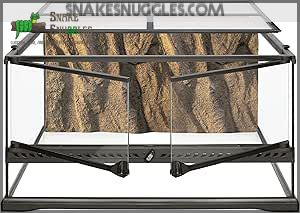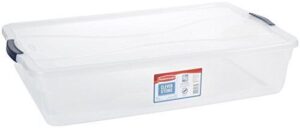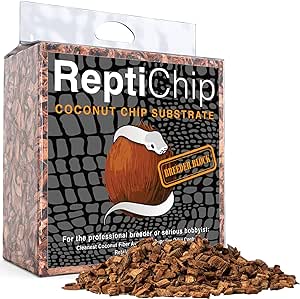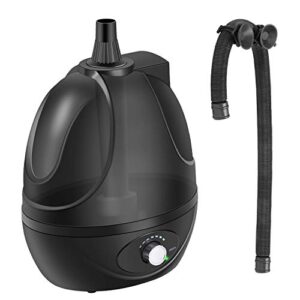This site is supported by our readers. We may earn a commission, at no cost to you, if you purchase through links.
A $50 corn snake seems like a bargain until you realize the glass terrarium costs $200, the heating system adds another $75, and you haven’t bought substrate, hides, or food yet. First-time snake owners often focus on the animal’s price tag while overlooking the enclosure and equipment that can easily triple their initial budget.
The snake itself represents just one piece of the financial puzzle. Your total investment depends on species size, enclosure quality, and whether you’re buying a common morph or a designer pattern that costs more than a used car.
Understanding both upfront and ongoing expenses helps you choose a snake that fits your budget without compromising the animal’s health or your wallet down the road.
Table Of Contents
- Key Takeaways
- Pet Snake Prices by Species and Morph
- Snake Enclosure and Setup Costs
- Ongoing Snake Care Expenses
- Top 5 Products for Affordable Snake Ownership
- Frequently Asked Questions (FAQs)
- How much does a pet snake cost?
- How much do corn snakes cost?
- How much does a California King Snake cost?
- How much does it cost to keep a snake?
- How much does a python snake cost?
- Why do snakes cost so much?
- How much does snake food cost?
- Is it expensive to own a snake?
- How much does a new snake cost?
- How much does a beginner snake cost?
- Conclusion
Key Takeaways
- The snake itself is just the starting point—you’ll spend $150 to $800 on the initial enclosure setup alone, with heating equipment, substrate, hides, and monitoring devices often costing more than the animal.
- Common beginner snakes like corn snakes and ball pythons cost $25 to $200 for standard morphs, but rare designer genetics can reach $20,000 to $70,000 depending on breeding difficulty and collector demand.
- Monthly expenses run $15 to $70 depending on your snake’s size, with feeding costs, electricity for heating, and substrate replacements adding up faster than most first-time owners expect.
- Buying from breeders typically saves you 30 to 50% compared to pet stores, while rescue adoption fees of $50 to $125 include health checks and quarantine care that reduce your upfront veterinary costs.
Pet Snake Prices by Species and Morph
Your snake’s price tag depends largely on the species you choose and whether you’re buying a common color pattern or a rare genetic morph. Beginner-friendly snakes like corn snakes and ball pythons won’t break the bank, but if you’re after specific colors or patterns, you’ll pay more.
Let’s break down what you can expect to spend across different species and morphs.
Common Beginner Snakes and Their Costs
Common pet snakes offer budget-friendly entry points for beginners. You’ll find these popular species at accessible prices:
- Corn snakes – Standard morphs cost $25-$200, making them ideal starter pets.
- Ball pythons – Normal hatchlings range from $50-$150, with juveniles reaching $400.
- Garter snakes – Priced at $20-$300 depending on subspecies.
- King snakes – California kings generally sell for $89-$149.
- Milk snakes – Common varieties start around $129.
Temperament and availability keep these species affordable. The price of ball pythons can vary greatly based on their unique morphs and traits.
Rare and Expensive Snake Morphs
While common snakes suit beginners, rare morphs attract serious collectors. Designer ball pythons like Sunset or Stranger can reach $20,000–$70,000, while the legendary blue morph green tree python has sold for over $445,000. Scaleless mutations and paradox patterns command premium prices due to morph rarity and breeding difficulty.
While common snakes cost under $200, rare designer morphs like blue green tree pythons have sold for over $445,000
Investment potential drives these snake morph prices, though values fluctuate as availability changes. The Blue Eyed Leucistic Ball Python is especially prized. You’re paying for genetics, not just appearance.
Breeder Vs. Pet Store Pricing
Where you buy impacts your wallet more than you’d expect. Breeders generally charge 30–50% less than pet stores, especially for common morphs. Pet stores add retail overhead, inflating snake prices for convenience.
Consider these breeder advantages:
- Direct morph price impact: Breeders offer competitive pricing on trending genetics
- Quality assurance costs: Health guarantees and lineage transparency justify pricing
- Negotiating breeder prices: Flexible pricing and bulk discounts available
- Long-term value: Better cost of pet ownership through healthier stock
- Snake species cost comparison: Wider variety with lower markups
You’re paying for convenience at stores, but breeders deliver better snake species value.
Adoption and Rescue Fees for Snakes
Pet snake adoption through animal shelters and reptile rescues costs $10–$250, far less than buying. You’ll generally pay $50–$125, with fee variations reflecting veterinary costs already covered—quarantine, fecal tests, and health checks.
Species influence pricing; ball pythons and corn snakes sit mid-range, while harder-to-place snakes may carry waived fees. Regional policies and surrender fees shape final costs, making rescue adoption a smart entry into responsible pet ownership.
Snake Enclosure and Setup Costs
Your snake’s home can cost more than the snake itself, so choosing the right enclosure matters.
Options range from basic plastic tubs under $20 to custom terrariums well over $300.
Here’s what you’ll pay for each type and what comes with it.
Terrarium, Aquarium, and Plastic Tub Options
Your enclosure choice affects both your budget and your snake’s health. Glass terrariums designed for reptiles range from $125 to $475 and offer excellent ventilation requirements and aesthetic appeal. Standard aquariums cost $100-$250 but need DIY modifications for airflow and humidity control. Plastic tubs provide budget-friendly reptile enclosures starting at $20, with premium PVC snake enclosures reaching $299-$550.
- Budget-conscious: Basic plastic storage tubs work perfectly for many species
- Display-focused: Glass terrariums showcase your snake while maintaining proper cage conditions
- Professional-grade: PVC enclosures offer enhanced insulation and customization options
Substrate Materials and Price Ranges
Substrate materials for your snake enclosure range from budget-friendly to premium options. Compressed coconut brick bedding offers excellent value—one 10 lb block expands to replace multiple bags and costs less per quart than pre-fluffed products.
Fine coconut fiber substrates run about $1.03 per quart in 36-quart bags, while branded reptile bedding like ReptiChip costs around $1.11 per quart for enhanced humidity control.
Essential Accessories and Their Costs
Your snake enclosure needs a few core accessories beyond just substrate.
Hides and shelters run $14-$50 per piece—you’ll need at least two for proper security. Water bowls cost $3-$35 depending on size.
Heating elements like under-tank pads average $27, while ceramic heat emitters start around $13. Monitoring devices for temperature and humidity range from $10-$22.
Control systems like basic thermostats begin at $35 to regulate heating safely.
Initial Setup Cost Estimates
Getting your first snake ready means putting together several pieces. Starter kit costs for complete 10-gallon setups run $100-$150, while 40-gallon packages with heating equipment and furnishing costs reach $350-$450.
DIY enclosure costs and substrate materials push basic setups to $150-$300.
For custom builds with sophisticated heating element costs, your initial investment climbs toward $800-$1,500 depending on species requirements.
Ongoing Snake Care Expenses
Once your snake is settled in, you’ll need to budget for recurring expenses that keep your pet healthy and comfortable. Feeding, heating, and routine maintenance add up over time, so it’s important to know what you’re signing up for.
Here’s what to expect each month and year.
Monthly Feeding Costs by Snake Size
Your snake feeding costs depend heavily on size and metabolic rates. Hatchling feeding runs about $1 monthly for corn snakes eating pinkie mice weekly. Adult feeding for medium ball pythons averages $25-$30 monthly on rats. Larger snakes consuming jumbo rats can reach $40-$70 per month.
Species variation matters—faster metabolisms mean higher bills. Cost reduction strategies include bulk buying frozen prey or breeding feeders yourself.
Heating, Lighting, and Electricity Expenses
You’ll spend roughly $5–$25 monthly on electricity for your snake’s heating and lighting equipment. A 100-watt heat lamp plus a 20-watt UVB bulb running 12 hours daily costs about $5 per month at standard U.S. rates.
Consider these factors affecting your heating costs:
- Thermostat use reduces energy consumption by 30–50%
- Seasonal variation increases winter heating expenses by 30–40%
- Larger enclosures and higher wattage equipment raise electricity expenses
- Energy efficiency improves with ceramic heat emitters over traditional bulbs
Cleaning and Substrate Replacement Costs
Beyond heating costs, you’ll budget $10–$30 monthly for cleaning supplies and substrate materials. Coconut coir blocks run $10–$15 per replacement, while aspen bedding costs $8–$9 for a 4-quart bag. You’ll replace substrate every 4–6 months depending on enclosure size and cleaning frequency.
| Substrate Type | Cost Range |
|---|---|
| Coconut Coir | $10–$15 per block |
| Aspen Bedding | $8–$9 per bag |
| Forest Bark | $6–$11 per container |
| Sphagnum Moss | $5–$30 per volume |
Bioactive setups reduce long-term expenses through natural waste breakdown. Larger snake enclosure maintenance requires more reptile bedding, increasing your substrate and habitat materials investment proportionally.
Veterinary Care and Emergency Expenses
While substrate and electricity costs stay predictable, veterinary care can challenge your long-term budgeting. Routine wellness exams run $40–$80, but diagnostic costs escalate quickly when snake health problems appear. Respiratory infections alone cost around $200 for treatment.
- Emergency surgeries range from $1,800–$5,000
- Imaging and bloodwork add $150–$700 per visit
- Pet insurance may reimburse 50% of qualifying bills
- Preventative care reduces costly emergency expenses
Maintaining an emergency fund protects you from unexpected veterinary costs for snakes.
Top 5 Products for Affordable Snake Ownership
You don’t need to empty your wallet to set up a proper snake habitat. The right products can keep your costs down while still meeting your snake’s needs for temperature, humidity, and space.
Here are five affordable options that experienced keepers rely on.
1. Exo Terra Reptile Terrarium Short Wide
The Exo Terra Short Wide terrarium (18″×18″×18″) offers a practical reptile enclosure for hatchling and juvenile snakes. This glass terrarium features front-opening doors for easy maintenance, dual ventilation that prevents condensation, and cable routing ports for your heating elements.
You’ll find it suitable for corn snakes, kingsnakes, and juvenile ball pythons—though adults generally outgrow this 25-gallon snake enclosure setup.
Pricing analysis shows it retails around $115–$190, positioning it as an intermediate-cost option. Consider plastic storage tubs as budget-friendly alternative enclosures for smaller species.
Best For: Reptile keepers housing hatchling or juvenile snakes like corn snakes, kingsnakes, and ball pythons who want a well-ventilated glass enclosure with easy front access.
- Front-opening doors make feeding and cleaning much easier than traditional top-entry tanks
- Dual ventilation system keeps glass clear and maintains proper airflow for humid setups
- Raised bottom lets you safely install under-tank heaters while built-in ports handle all your cables and tubing
- At 18″×18″×18″, it’s only suitable for juveniles—most adult snakes will need an upgrade within a year or two
- Glass construction is fragile during shipping, and several buyers report receiving cracked or broken units
- Price ranges from $115–$190, making it pricier than basic plastic tubs that work just as well for many species
2. Exo Terra 55 Gallon Screen Cover
A secure snake habitat needs proper ventilation and escape prevention—that’s where the Exo Terra 55 Gallon Screen Cover comes in. This metal mesh lid fits standard 48″×13″ reptile enclosures and allows UV penetration for your overhead lighting while maintaining airflow across your snake’s terrarium.
You’ll pay roughly $13–$20 for this enclosure component, though you should budget an extra $2 for the recommended clips that lock it firmly to your tank rim. The durable steel frame resists warping and offers straightforward cleaning ease between substrate changes.
Best For: Snake keepers who need a secure, well-ventilated lid for standard 55-gallon enclosures that allows heat and UV lighting through without blocking airflow.
- Durable metal mesh on a solid steel frame resists warping and allows full UV penetration for overhead basking lamps
- Easy to clean and maintain with no moving parts or mechanical wear points to fail over time
- Affordable at $13–$20 with straightforward drop-in installation on standard 48″×13″ aquarium rims
- Requires separate clips (around $2 extra) to secure properly and prevent escape-prone snakes from pushing through
- Open mesh design increases evaporation, so you’ll need extra humidity monitoring for moisture-dependent species
- May arrive with minor dents from shipping or need slight bending adjustments for a perfect fit on some tank brands
3. Rubbermaid 41 Quart Storage Tote
Budget-conscious keepers often use the Rubbermaid 41 Quart Cleverstore Tote (29″×18″×6″) for DIY snake racks that house juvenile or smaller species. You’ll spend $10–$20 per unit, then add ventilation modifications—drill holes or install mesh inserts—to maintain airflow and escape prevention.
The latching lid and stacking capability let you build vertical enclosures in tight spaces, though the 6-inch height limits use to hatchlings or compact adults.
Heat retention requires supplemental pads or tape, and the thin plastic may warp under prolonged heat exposure.
Best For: Budget-conscious snake keepers housing juveniles or small species in DIY rack systems who are comfortable with basic modifications like adding ventilation.
- Affordable at $10–$20 per unit with secure latching lids that stack vertically to save space
- Clear plastic allows quick visual checks without opening the enclosure
- Lightweight and easy to clean, making routine maintenance straightforward
- Low 6-inch height limits use to hatchlings or very small snakes
- Requires DIY modifications for proper ventilation and supplemental heating equipment
- Thin plastic may warp under heat or bend under weight over time
4. ReptiChip Coconut Reptile Substrate Bedding Block
You’ll expand a single $20–$30 compressed 72-quart ReptiChip coconut substrate block with water to fill large enclosures at a fraction of traditional bedding costs. The 1/8- to 1/4-inch chips retain humidity for tropical species while absorbing waste odors through natural decomposition. Spot-clean debris between full changes every 4–6 weeks.
The coarse texture aids tunnel construction in burrowing colubrids and holds moisture longer than fiber alternatives, though initial dust requires ventilation during setup.
Pre-expanded 12-quart bags cost $20—less economical than bulk blocks for most keepers.
Best For: Reptile keepers with large enclosures who need cost-effective, humidity-retaining bedding for burrowing species like ball pythons, leopard geckos, and tortoises.
- One compressed block expands to 72 quarts for around $20–$30, making it way more economical than pre-expanded bags
- Holds humidity really well and absorbs odors naturally, which cuts down on how often you need to mist or clean
- The chunky texture lets burrowing reptiles dig tunnels that actually stay put, plus it’s compostable when you’re done with it
- Gets pretty dusty when you first expand it, so you’ll want good ventilation or a mask during setup
- Requires about 30 liters of water and some mixing time before it’s ready to use in the enclosure
- More expensive per quart than basic options like aspen or newspaper if you’re on a tight budget
5. BaoGuai Reptile Mister Fogger Humidifier
The 2.5-liter BaoGuai fogger runs 12 hours per fill and directs mist through a flexible hose into tropical snake enclosures, supplementing heating equipment when ambient humidity drops. Clean the hose and reservoir weekly to prevent biofilm buildup that clogs output.
You’ll pay mid-range market price for basic ultrasonic fog without digital controls—pair it with a separate hygrometer to monitor levels.
Budget for replacement after 18–24 months of daily use, a recurring pet expense for humidity-dependent colubrids and pythons.
Best For: Small to medium tropical snake keepers who need affordable daily humidity control and don’t mind weekly cleaning or eventual replacement.
- 12-hour runtime on a single 2.5L fill means you only refill twice daily for most setups
- Flexible hose lets you direct fog exactly where your snake needs it—into hides or specific enclosure zones
- Mid-range price gets you working fog output without paying for digital controllers you may not need
- Hose and tank need weekly scrubbing to stop biofilm from clogging the mist and creating health risks
- No built-in hygrometer or timer means you’re buying and checking separate humidity monitors
- Expect to replace the unit every 18–24 months with daily use as pumps and hoses wear out
Frequently Asked Questions (FAQs)
How much does a pet snake cost?
You’ll find corn snakes at just $10, while a rare Sunset Ball Python can cost $70,
Most beginner-friendly species fall between $40 and $300, with morph pricing, breeder options, and adoption fees affecting your total snake ownership costs.
How much do corn snakes cost?
Corn snakes average $30 to $200, depending on age and morph. Common patterns cost $40 to $100, while rare morphs like Palmetto can reach $1, Breeders generally charge more than pet stores.
How much does a California King Snake cost?
In the budget snake world, California King Snakes are the best. Normal morphs start around $50 to $100, while rare Lavender Snow morphs can command $500, depending on age, gender, and breeder reputation.
How much does it cost to keep a snake?
Keeping a snake usually costs $10 to $30 monthly for food and substrate, plus $50 to $100 annual vet visits. Long-term budgeting should include unexpected costs like emergency care, which can exceed $500 per incident.
How much does a python snake cost?
Ball pythons start around $10 to $100 for normals, but designer morphs cost $200 to $ Rare genetics can reach $5,000 or more, with breeding females commanding premium prices over males.
Why do snakes cost so much?
Here’s the real sticker shock: breeding investment, morph rarity, and setup complexity drive snake species and prices sky-high.
Add veterinary expenses and the long-term costs of owning a pet snake, and you’ll see why.
How much does snake food cost?
Snake food costs between $6 and $30 monthly, depending on your snake’s size and feeding frequency. Bulk buying frozen feeders reduces expenses considerably.
Feeder size and live vs. frozen options affect your feeding costs.
Is it expensive to own a snake?
No, owning a snake won’t drain your wallet—if you avoid the hidden costs and unexpected expenses. Long-term budgeting and smart affordability factors make reptile ownership surprisingly manageable for most lifestyles.
How much does a new snake cost?
You’ll spend between $40 and $150 for most beginner snake species like corn snakes or ball pythons. Rare morphs push prices into the thousands, while rescue adoptions may cost under $
How much does a beginner snake cost?
For beginner pet snakes like corn snakes, you’ll usually spend $40 to $100 for common morphs. Garter snakes cost between $20 and $60, while hognose snakes range from $100 to $700 depending on morph rarity.
Conclusion
Thinking snakes are cheap pets ignores the real picture: a $40 corn snake needs a $300+ habitat before it even eats its first meal. Knowing how much snakes cost means adding up the animal, enclosure, heating elements, substrate, and monthly feeders.
Budget for the complete system upfront rather than discovering surprise expenses later. Your snake deserves proper equipment from day one, and your wallet deserves an honest assessment before you bring a reptile home.

















